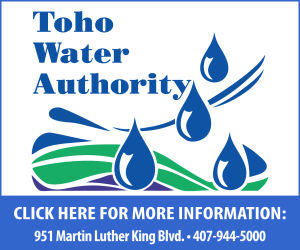At a recent meeting held by the Florida Fish and Wildlife Commission (story posted Thursday), area residents were given a grim picture of the current state of Kissimmee’s Lake Tohopekaliga and the even bleaker prospects for improvement anytime soon.
FWC staff stated the lake had 70 percent coverage of hydrilla, and over $6 million was needed immediately to fund the spraying and mechanical hydrilla removal necessary to open up the lake. The hydrilla expansion was not news to the over 70 residents who attended the meeting, equally split between lakeshore property owners and lake users, including anglers, waterfowl hunters, and jet skiers.
As questions were asked, it quickly became apparent that these stakeholders, hoping to spur action, are facing the issue of no one agency with some authority over a facet of lake management that can solve the problem. Neither Osceola County nor the cities that front Lake Toho and East Lake have any authority beyond the lakeshore. FWC manages fish and wildlife resources and is responsible for battling the invasive aquatic plant species, including hydrilla, that take habitat from those resources, including endangered species such as the snail kite. The South Florida Water Management District (SFWMD) has responsibility for both water quality and flood control, which in turn can affect FWC’s efforts. The U.S. Army Corps of Engineers adds a federal layer of jurisdiction over the Kissimmee Chain of lakes, which is considered navigable waters that can get you to Lake Okeechobee and from there theoretically out to the Atlantic Ocean or the Gulf of Mexico—provided you can get through the Lake Toho hydrilla first.
One question came up as to possible high levels of nutrients, both from Shingle Creek, which flows into Lake Toho from southern Orange County, and the ever-increasing lakeside development, are contributing to the overwhelming hydrilla growth. According to the SFWMD website, this has been under study since 2010 with results yet to be released.
It has been many years since FWC allocated funds for hydrilla removal in Lake Toho, despite the agency requesting contingency funds in each of the last three years. With the exception of some on the FWC staff, who truthfully stated that in past years anglers advocated for some hydrilla to remain, there is not a sense of urgency on the part of any regulatory agency to tackle their part of the solution, let alone to work cooperatively. What is needed now is for those using or living on Lake Toho to form a coalition to gain attention to what is happening to Lake Toho, focus agencies on the problems, fund the actions needed to clear up the lake, and then keep it clear.
Local governments can assist by providing expertise in government relations and prioritizing lake actions with their legislative lobbyists, but it has to start with concerned residents. Lake Toho is the first major body of water in the Kissimmee River and the Everglades system. Untold millions are being spent to improve those areas, and it is only logical that what happens at the head of the system, good or bad, affects everything literally downstream.
Terry Lloyd is a freelance journalist and writer who has been a St. Cloud resident since 2000. He enjoys the Florida outdoors, and as a previous director of the Kissimmee Gateway Airport, exercised environment stewardship of the airport property, which borders the Shingle Creek Preserve along Hoagland Boulevard.




